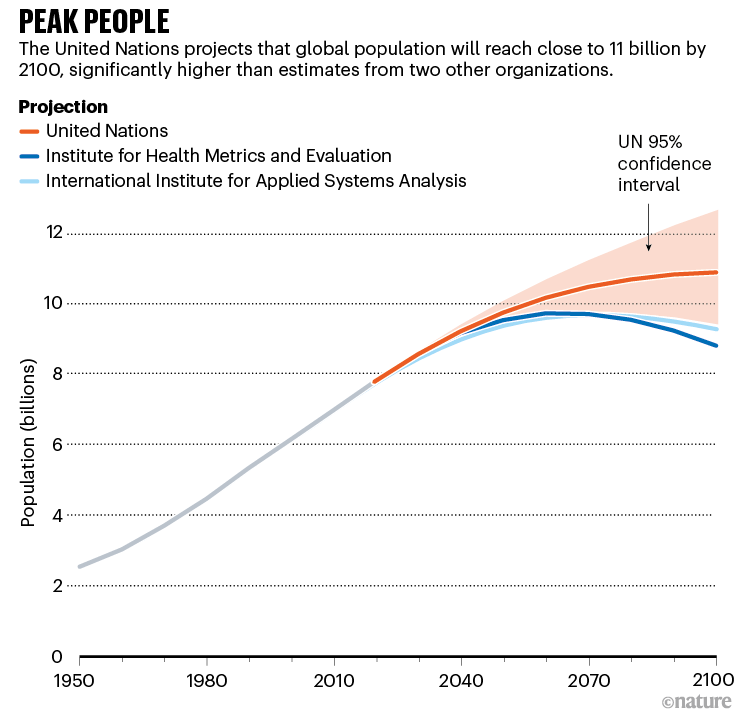Why With a Drop in Worldwide Birth Rates Does the World Population Continue to Grow
The 1980s were a puzzling time for would-be parents in Singapore. The government initially told them to "Stop-at-Two" and backed up the policy with a series of measures to deter couples from having three or more children. It increased hospital fees for the delivery of third babies and withdrew maternity pay.
In March 1987, officials performed a demographic U-turn. Under the awkward slogan "Have Three or More (if you can afford it)", the scales tipped abruptly towards those with larger families, who were now given priority for schools and housing.
Singapore is a dramatic example, but far from unique. Across the world, to secure a stable financial future, governments are desperate to keep national population numbers in a Goldilocks zone: not too many, not too few. And many of these policies are based on computer simulations of how future population numbers will rise and fall.
For decades, the most influential of these projections was produced by a small group of population modellers at the United Nations. But in the past few years, rival groups have developed their own techniques and produced their own results — which vary considerably and have generated bitter disputes in the field.
The UN says world population will plateau at 10.9 billion by the end of the century. The other groups forecast earlier and smaller peaks, with global population reaching 9.7 billion by 2070 and then declining.
The difference poses a conundrum for governments, companies and others trying to plan for everything from investment in infrastructure and future tax income, to setting goals for international development and greenhouse-gas reductions.

The fraction of the global population at risk of floods is growing
No matter which model is used, the most important data are precise numbers of who lives in each country today — and researchers are developing ways to improve these tallies. This is crucial, not only to provide a solid baseline from which to project into the distant future, but also to develop policies for today, such as allocating COVID vaccinations and providing adequate numbers of school places. And the pandemic has complicated things by delaying some censuses and potentially changing predictions for life expectancy and birth rates, at least in the short term.
That adds up to a growing research and policy interest in the planet's human resources.
"Every government is interested in what is going to happen to their population in the next couple of decades, for pragmatic economic reasons and planning needs," says Tomáš Sobotka, a population researcher at the Vienna Institute of Demography.
Headcount
All estimates of population start with the same question: how many people are alive right now? Attempts to answer that question go back to 4000 bc, when the Babylonians used a census to work out how much food they needed to feed their people. Ancient Egyptian, Roman and Chinese societies all carried out regular counts.
Earlier this year, both China and the United States reported results from censuses carried out in 2020. Many more countries were scheduled to release results this year but have been delayed by the ongoing COVID-19 pandemic. "China and the US were very much the exceptions in getting their censuses done," says Patrick Gerland, who leads demographic work at the UN Population Division in New York City, which produces the UN projections.
Both the United States and China reported that they are experiencing record low levels of population growth. Those results made headlines, but they are in line with what demographers expected, says Gerland. That's because both countries track and produce regular, reliable data on births and deaths, which allow population researchers to monitor trends in almost real time.
With census results or other population counts as a baseline, demographers forecast the various ways in which the number of people will change in coming years. Beyond births and deaths, researchers also predict how many people will enter or leave a country over time.
Like all simulations of future events — from climate change to the course of an epidemic — population predictions get less reliable as they are projected over longer time periods. For demographers, projections over the next 20–30 years are usually considered to be very good because most people who will be alive in a few decades' time have already been born. And birth, death and migration rates are fairly easy to extrapolate over that period from recent trends.
These short- to medium-term predictions do remain vulnerable to shocks, however. Demographers are racing to understand the impact of the COVID-19 pandemic, for example. In some of the worst-hit countries, the large number of deaths in a relatively short period has already had an effect in lowering life expectancy.

The United Nations forecasts that Nigeria's population will more than triple by the end of the century. Credit: Sean Sutton/Panos Pictures
With migration suspended between most countries, the biggest other factor in these post-pandemic calculations of population is the impact on births. Called the fertility rate, the number of children each woman has on average is a totemic figure in demography. That's because, with death rates and migration usually fairly stable in comparison, large swings in the fertility rate tend to dominate both the actual size of a population and predictions of how that population will shrink or grow in future.
When Singapore, for example, first urged each family to have only two children at most in 1972, the fertility rate in the country was estimated at 3.04 and was forecast to rise sharply. By 1986, just ahead of its policy U-turn and plea for more babies, fertility had plummeted to 1.43. It dipped as far as 1.14 in 2018 and today remains at a worryingly low 1.23.
To maintain a stable population without immigration, a country's fertility rate needs to be at the 'replacement level' of 2.1 births per woman.
Predictions of population in both the near and long-term future typically come down to estimates of how quickly fertility will change. And that means demographers have to make some educated guesses about how people will behave as their circumstances alter. In high-income countries, these behavioural changes are usually driven by economic factors. As opportunities emerge, women prioritize careers, and couples delay having children during a recession.

How many people has the coronavirus killed?
In less-wealthy nations, other factors dominate. As more girls are educated, they tend to have fewer children and to have them later. And more people have access to contraception as health systems and distribution networks improve. In that sense, falling fertility rates reflect economic development.
Demographers expect that the pandemic will cause a short-term dip in fertility, in richer countries at least, because of the associated economic uncertainty. By contrast, poorer countries could see a surge in pandemic births because of the disruption to contraception supplies.
In a preprint1, Sobotka and colleagues report on data for 17 countries across Europe, Asia and the United States showing that the number of births did fall — on average by 5.1% in November 2020, 6.5% in December 2020 and 8.9% in January 2021, compared with the same months of the previous year. Spain sustained the sharpest drop in the number of births among the countries analysed, with that metric plummeting by 20% in December 2020 and January 2021 compared with a year earlier.
Some experts predict that births will rebound. "By October it looks like we might be back to normal birth volume," says Molly Stout, an obstetrician at the University of Michigan Health in Ann Arbor. Over the course of the pandemic, Stout's team has used electronic health records to model the number of pregnancies in the surrounding community and so plan for an expected number of births. Its published analysis2 accurately predicted a 14% year-on-year fall in births between November 2020 and March 2021, and suggested a comparable surge in births in the last third of 2021.
Future faces
How fertility rates and population numbers will change in the longer term, over several decades or more, is more difficult to predict. And this is where the serious controversy starts.
For decades, the UN Population Division had the field largely to itself, and churned out routine updates every couple of years. Its most recent report, published in 2019, forecasts that global population will continue to rise from its current 7.7 billion and could reach nearly 11 billion by 2100. (Its next biennial update was due this year but has been postponed to 2022.)

IPCC climate report: Earth is warmer than it's been in 125,000 years
In 2014, a group at the International Institute for Applied Systems Analysis (IIASA) in Vienna produced its own forecast. It said that world population is most likely to peak at 9.4 billion around 2070 and will fall to 9 billion by the end of the century. The group's numbers rose slightly in a 2018 report3 that projected a peak of about 9.8 billion around 2080; a subsequent update has population cresting at a little under 9.7 billion around 2070.
And then, last year, a paper4 from a team at the Institute for Health Metrics and Evaluation (IHME) at the University of Washington's School of Medicine in Seattle, suggested that global population will peak at around 9.7 billion in 2064, and then decline to about 8.8 billion by 2100.
Some 23 countries could see their current population halved by the end of the century, the study said, including Japan, Thailand, Italy and Spain.
The different outcomes reflect the uncertainty in making projections over such a long time period, says Leontine Alkema, a statistical modeller at the University of Massachusetts Amherst. "It's kind of an impossible exercise and so we do the best we can and it's good that different groups use different approaches," she says.
The huge range between the studies (see 'Peak people') comes down to the way each research group sets up its forecast. "All three have used a similar starting point [for population] so we know that's not the problem," says Toshiko Kaneda, a demographer at the Population Reference Bureau, an independent research organization in Washington DC. "The issue then is how you think the line will creep up. The assumptions there are where people get it wrong."

Source: UN Population Division/IIASA/IHME
Changes in fertility rates with anticipated economic development are key, and the three models account for this process in different ways. The UN modellers divide the way that fertility tends to slow, decline and then recover into several phases. Changes in each country's birth rate in recent years are then used to place each nation into one of these phases, and some 100,000 possible pathways for future fertility are modelled. The UN then takes the median of these projections and presents it as the most likely scenario.
Instead of relying on data and past trends to forecast future falls in fertility due to development, the IIASA group turned to expert judgement. They asked some 200 researchers, including economists, demographers and sociologists, to predict fertility rates for individual countries in 2030 and 2050, on the basis of what they expected to happen to several social, health and economic factors. Some of these estimates varied considerably. Forecasts of fertility rates in India ranged from 1.5 to 2.5 for 2030 and from 1.1 to 2.5 for 2050.
IIASA's fertility-rate forecasts are noticeably lower than the UN's. For example, the researchers estimate that fertility for every country in sub-Saharan Africa will be below the replacement level of 2.1 by the end of the century. The UN forecasts that only one-third of countries in the region will fall below this level.
The IHME team did things quite differently. Instead of basing its model on fertility rates, and how they would change, the group used a variable called completed cohort fertility at 50 years (CC50). This counts the number of children each woman has had by the time she reaches 50. It is subtly different from overall fertility rate because it is less sensitive to the age at which women have their children, and it does not show the same rebound effect when fertility drops to low levels.
And instead of assuming a figure for this CC50 at specific time points in the future, the IHME model used real-world data to work out the relationship between CC50 and its two main drivers: educational attainment and unmet contraceptive need. This meant they could plug national data on education and contraception — and how they expected them to change — into the model instead of simple estimates of future fertility.

COVID vaccines to reach poorest countries in 2023 — despite recent pledges
Christopher Murray, who leads the IHME team, says this approach makes the IHME forecast more reliable and more valuable because it can test the impact of changes and assumptions. The model could forecast what happens to population when policies encourage more girls to spend longer in school, or when health infrastructure improves to secure more reliable access to contraception. "In the policy realm it's much more useful to have models with causal connections," Murray says.
Plenty of demographers disagree. "There are a few issues with those [IHME] projections that are a little bit problematic," says Stuart Gietel-Basten, a demographer at the Hong Kong University of Science and Technology. Together with Sobotka in Vienna, Gietel-Basten published a preprint5 of a technical critique of the IHME study that highlights what they claim are "internal inconsistencies, discrepancies and illogical and implausible trends".
For example, the duo points to Iraq, which the IHME forecasts will boast the world's fourth-highest female life expectancy by 2100, as well as welcoming huge numbers of immigrants in the coming decades. The critics say this is highly unlikely. Sobotka and Gietel-Basten have organized a critical letter signed by 170 demographers and sent it to The Lancet, which published the IHME paper. The letter has not yet been published.
"The big concern I have is that a projection can shape the future," says Gietel-Basten. "If you're going to say we are going to have very, very low fertility, rapid population ageing and stagnation, well that's not what governments want." As seen in Singapore, politicians can react with policies designed to prevent or, more commonly, produce more babies. "They can react by restricting access to family planning, restricting access to abortion and restricting access to vasectomies."
Kaneda says that the IHME group that produced the paper has little background in demography. Instead, it based its population forecast on methods it developed to calculate a regular set of health statistics called the Global Burden of Disease. "I think it's a great effort, just that they should go back and revise some of this stuff," says Kaneda.
Murray rejects the criticism, saying that the UN model itself carries its own "strange set of assumptions" and that the demography community is reluctant to accept ideas from outside the field. "Let's look at how forecasts go in the next five or ten years in places with low fertility," he says. "Are we going to see in China and Korea and Singapore, Greece and Spain that fertility shoots up as the UN says, or not? I think we won't."
The UN's past forecasts have a decent track record. In 1968, for example, the UN projected that the global population in 1990 would be 5.44 billion — within 2% of the best estimate of the real figure of 5.34 billion. In 2010, the estimated global population was 7 billion, compared with projections in previous UN reports that ranged from 6.8 billion to 7.2 billion.
The organization is also using new and better sources of data about populations in specific countries to upgrade its historical records, Gerland says. This will make the modelling more accurate, he adds, and should allow for more regular updates — although the current update is taking longer than expected and has delayed the latest global population report.
Right here, right now
Some demographers stay on the sidelines. "I steered well clear of getting involved in any of that because it got quite nasty and it's very difficult to really say what's the better approach," says Tom Wilson, a demographer at the University of Melbourne, Australia. "The one thing unfortunately about population projections is they will always turn out to be wrong."

COVID boosters for wealthy nations spark outrage
That's why some in the field prefer to leave the future alone and focus instead on improving the accuracy of data used immediately to set policy: counting people alive right now. In some places, especially those facing instability and civil strife, that's more difficult than it sounds. "In Afghanistan, the last census was in 1979. In the DRC it was 1984," says Andy Tatem, a population researcher at the University of Southampton, UK. In those cases, governments tend to assume a linear annual increase to estimate current numbers. But that could be wildly inaccurate. A 2017 analysis6 by researchers at the University of Antwerp in Belgium found that national population estimates used by the government of the Democratic Republic of the Congo ranged from 77 million to 102 million.
To produce better data, researchers are testing ways to count people without actually counting them.
One technique is to monitor mobile-phone traffic. By tracing calls to the phone towers that send and receive them, researchers can use call density around the towers to estimate the local population. In one high-profile application of this technique, researchers from Sweden and South Korea tracked the displacement of people after a devastating earthquake struck Haiti in 2010. The research showed that the population of the capital, Port-au-Prince, shrunk by almost one-quarter within three weeks of the quake7.
Tatem's team has applied a similar technique to Namibia in a study of malaria prevalence in different parts of the country. The results suggested that Namibia was closer to eliminating the disease than policymakers realized at the time.
Researchers are also working to count people on the basis of the size and shape of the buildings they live in. Using satellite photos and image-recognition software, they can map settlements and individual houses, and then build up a picture of the number of residents. "We've done this to fill in gaps in the Colombia census and the Burkina Faso census, and to produce new estimates for the DRC and Zambia and quite a few other countries," Tatem says. "It's an approach that is starting to take off."
Even so, old-fashioned population counts still have their place. "The census collects so much more than just population numbers," Tatem adds. "These methods should be seen as a complement to the census rather than something to replace it."
Source: https://www.nature.com/articles/d41586-021-02522-6
0 Response to "Why With a Drop in Worldwide Birth Rates Does the World Population Continue to Grow"
Post a Comment